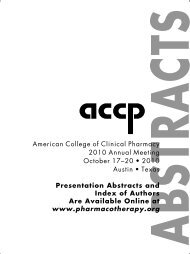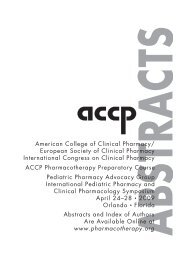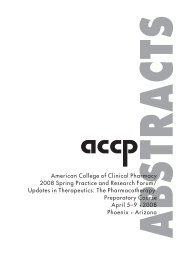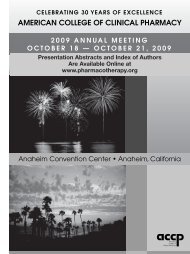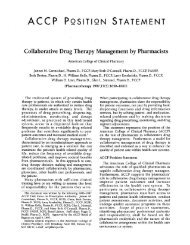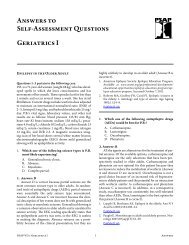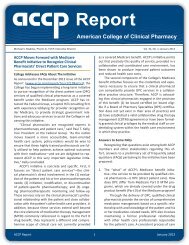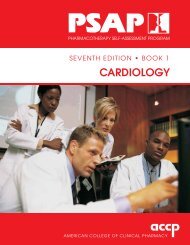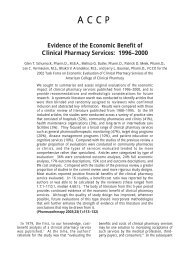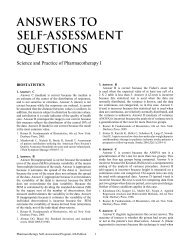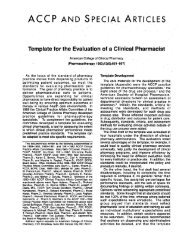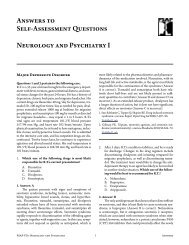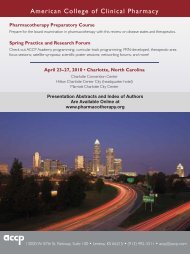Answers to Self-Assessment Questions - ACCP
Answers to Self-Assessment Questions - ACCP
Answers to Self-Assessment Questions - ACCP
Create successful ePaper yourself
Turn your PDF publications into a flip-book with our unique Google optimized e-Paper software.
in this patient population because there is no evidence that<br />
they improve outcomes.<br />
1. Garrel D, Patenaude J, Nedelec B, Samson L, Dorais J,<br />
Champoux J, et al. Decreased mortality and infectious<br />
morbidity in adult burn patients given enteral glutamine<br />
supplements: a prospective, controlled, randomized clinical<br />
trial. Crit Care Med 2003;31:2444–9.<br />
2. Prelack K, Dylewski M, Sheridan RL. Practical guidelines for<br />
nutritional management of burn injury and recovery. Burns<br />
2007;33:14–24.<br />
47. Answer: D<br />
The medical resident would like <strong>to</strong> discuss changing<br />
R.R. <strong>to</strong> an immune-enhancing EN formulation with<br />
omega-3 PUFAs and antioxidants. The correct response <strong>to</strong><br />
this suggestion would highlight that immune-enhancing<br />
EN formulations shown <strong>to</strong> be beneficial in a specific<br />
patient population may not be associated with the same<br />
improvements in outcomes in other patient populations.<br />
The correct response is that the suggested change should<br />
not be made because an immune-enhancing EN formulation<br />
with omega-3 PUFAs 8.6 g/L and antioxidants is associated<br />
with increased survival in patients with sepsis and ARDS<br />
but has not been evaluated in patients with burns (Answer<br />
D). An immune-enhancing EN formulation with omega-3<br />
PUFAs 8.6 g/L and antioxidants has not been shown <strong>to</strong><br />
alter oxygenation in patients with burns (Answer B) or<br />
<strong>to</strong> increase survival in a nonseptic mixed medical ICU<br />
population (Answer C). Because an immune-enhancing EN<br />
formulation has not been evaluated in patients with burns,<br />
switching <strong>to</strong> an immune-enhancing product (Answer A) is<br />
incorrect.<br />
1. Garrel D, Patenaude J, Nedelec B, Samson L, Dorais J,<br />
Champoux J, et al. Decreased mortality and infectious<br />
morbidity in adult burn patients given enteral glutamine<br />
supplements: a prospective, controlled, randomized clinical<br />
trial. Crit Care Med 2003;31:2444–9.<br />
2. Prelack K, Dylewski M, Sheridan RL. Practical guidelines for<br />
nutritional management of burn injury and recovery. Burns<br />
2007;33:14–24.<br />
48. Answer: D<br />
The length of time that RR receives immunonutrition<br />
should be evidence-based. In one study that evaluated<br />
immunonutrition in patients with burns and demonstrated<br />
improved patient survival with enteral glutamine<br />
supplementation, immunonutrition was continued until<br />
complete wound healing was achieved (Answer D), making<br />
Answer D the correct answer. The other durations, until<br />
extubation (Answer C), 96 hours (Answer B), or 48 hours<br />
(Answer A), have been used as minimum therapy goals in<br />
other trials of immune-enhancing nutrients. However, in<br />
patients with burns, extending the duration of therapy until<br />
complete would healing occurs is more likely <strong>to</strong> result in<br />
additional benefit.<br />
1. Garrel D, Patenaude J, Nedelec B, Samson L, Dorais J,<br />
Champoux J, et al. Decreased mortality and infectious<br />
morbidity in adult burn patients given enteral glutamine<br />
supplements: a prospective, controlled, randomized clinical<br />
trial. Crit Care Med 2003;31:2444–9.<br />
2. Prelack K, Dylewski M, Sheridan RL. Practical guidelines for<br />
nutritional management of burn injury and recovery. Burns<br />
2007;33:14–24.<br />
49. Answer: C<br />
Clinicians should be aware that harm might result from<br />
the use of immune-enhancing EN formulations in certain<br />
patient populations. Some evidence indicates that argininecontaining<br />
immune-enhancing diets may be harmful in<br />
critically ill patients with severe sepsis. Therefore, the<br />
62-year-old man with severe sepsis and an APACHE II score<br />
of 26 (Answer C) may be harmed by an arginine-containing<br />
immune-enhancing EN formulation, making Answer C the<br />
best answer. The 32-year-old patient with a urinary tract<br />
infection after severe trauma (Answer A) is likely <strong>to</strong> benefit<br />
from an arginine-containing immune-enhancing diet, as is<br />
the 59-year-old man with gastrointestinal (GI) cancer after<br />
colonic resection (Answer B); thus Answer A and Answer<br />
B are incorrect. The 48-year-old man in the medical ICU<br />
with an APACHE II score of 12 (Answer D) is less likely<br />
<strong>to</strong> benefit from an immune-enhancing diet, but he is not<br />
in a patient population in which additional harm has been<br />
suggested.<br />
1. Ber<strong>to</strong>lini G, Iapichino G, Radrizzani D, Facchini R, Simini<br />
B, Bruzzone P, et al. Early enteral immunonutrition in<br />
patients with severe sepsis: results of an interim analysis of<br />
a randomized multicentre clinical trial. Intensive Care Med<br />
2003;29:834–40.<br />
2. Kreymann KG, Berger MM, Deutz NE, Hiesmayr M, Jolliet<br />
P, Kazandjiev G, et al. ESPEN guidelines on enteral nutrition:<br />
intensive care. Clin Nutr 2006;25:210–23.<br />
50. Answer: C<br />
Glutamine is a major energy source for enterocytes and is<br />
associated with enhanced luminal barrier function (Answer<br />
A), but this effect is not a potential advantage of parenteral<br />
glutamine compared with enteral glutamine because this<br />
effect should occur regardless of the route of administration,<br />
so Answer A is incorrect. Arginine, not glutamine, increases<br />
the production of inducible nitric oxide (NO) (Answer B);<br />
thus, neither route of glutamine administration would be<br />
expected <strong>to</strong> produce this effect, and Answer B is incorrect.<br />
Increasing the production of heat shock proteins (Answer<br />
C) is an advantage of parenteral compared with enteral<br />
glutamine administration because this effect has been<br />
more strongly associated with parenteral supplementation<br />
than enteral supplementation, making Answer C correct.<br />
Glutamine by either route would be expected <strong>to</strong> increase<br />
T-helper lymphocytes, rather than decrease them as stated<br />
in Answer D; thus, Answer D is incorrect.<br />
1. Tjader I, Berg A, Wernerman J. Exogenous glutamine—<br />
compensating a shortage? Crit Care Med 2007;35(suppl):S553–<br />
S556.<br />
2. Suchner U, Kuhn KS, Furst P. The scientific basis of<br />
immunonutrition. Proc Nutr Soc 2000;59:553–63.<br />
51. Answer: D<br />
The use of PN is often necessary because of GI<br />
in<strong>to</strong>lerance or other complications of EN or because of the<br />
presence of a contraindication <strong>to</strong> EN. The use of immuneenhancing<br />
EN is often limited by the ability of the patient <strong>to</strong><br />
<strong>to</strong>lerate an adequate volume enterally, so feeding in<strong>to</strong>lerance<br />
Gastroenterology and Nutrition <strong>Answers</strong><br />
46<br />
Pharmacotherapy <strong>Self</strong>-<strong>Assessment</strong> Program, 6th Edition



